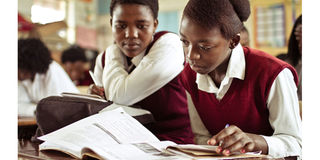
The new curriculum seeks to ensure learners gain knowledge, understanding, skills, values and a positive attitude for the world of work. The new curriculum is also learner-centred. PHOTO | FILE
Schools across Uganda are stuck with more than 4,000 incorrect textbooks for the New Lower Secondary Curriculum, which they received from the Ministry of Education and Sports in 2022.
A value for money audit report by the National Curriculum Development Centre (NCDC) revealed that 3,713 learners’ books and 242 teacher’s guides for various subjects were mistakenly delivered and remain unused.
The 2023/24 audit report indicates that elective subjects such as Islamic Religious Education, General Science, Performing Arts, and Technology and Design had the highest number of incorrectly delivered textbooks.
This has resulted in some schools having a surplus of incorrect books while others lack the necessary materials, highlighting significant disparities and inefficiencies in the distribution process.
“Audit field inspection indicated poor contract management by ministry officials, with publishers delivering large quantities of books to specific urban schools,” the report noted.
The 4,000 books were given to 11 sampled schools, suggesting the problem could be more widespread if all schools were sampled.
The audit also identified delays in textbook delivery. The government began distributing textbooks in 2022, two years after the curriculum implementation began, affecting the first cohort of students who had already reached Senior Two. This delay hindered the curriculum rollout as teachers and students lacked essential materials.
Criticism was also directed at NCDC’s use of the Uganda National Examinstaions Board (Uneb) database for distributing prototype books, which included only schools with examination centre numbers, excluding many others. This oversight further complicated the curriculum implementation.
A review of 35 sampled schools revealed serious inadequacies in textbook availability for the Competence-Based Curriculum (CBC). Some compulsory subjects had a student-to-textbook ratio as high as 1:294, while some elective subjects had no textbooks at all. This disparity hindered effective curriculum delivery.
Teachers also reported that the distributed books contained shallow content and numerous spelling errors. Consequently, the Ministry of Education and NCDC were urged to assess the inventory of distributed textbooks to better align materials with school needs and improve student-textbook ratios.
Dr Denis Mugimba, the Ministry of Education spokesperson, explained that the new lower secondary curriculum included 20 subjects, with each school selecting 15 subjects. He emphasised that school heads were required to specify their subjects to avoid receiving unnecessary materials.
“Head teachers should notify us of any subjects they do not teach so we can retrieve and redistribute wrongly delivered books,” Mr Mugimba said at the weekend.
The report also revealed significant issues with teacher training for the CBC. Despite the curriculum rollout in February 2020, only a few teachers had been trained, and many felt unprepared, especially for continuous assessment components. Of the 175 teachers sampled, 57.1 percent reported the training was ineffective.
Field inspections showed both public and private school teachers and head teachers lacked adequate training, with many delegating training to deputies who often didn’t relay the outcomes.
This left many educators unprepared to implement the new curriculum effectively. Additionally, 85.7 percent of teachers reported difficulties due to inadequate learning facilities, including classroom infrastructure, library resources, ICT facilities, and laboratory equipment. The current desk-to-student ratio averages 1:5, below the standard 1:3 requirement.
Furthermore, audit inspections and interviews revealed all sampled schools lacked sufficient ICT equipment for effective teaching. There is no policy guiding student use of personal laptops and phones for research. Teacher training in ICT use was also insufficient, with many still relying on traditional methods. While the ideal computer-to-student ratio is 1:1, the actual ratios range from 1:2 to 1:35 across classes Senior One to Senior Three.
Mr Mugimba remarked that teacher training effectiveness is subjective and varies among individuals. Addressing the issue of limited school facilities, he acknowledged it as a longstanding problem that cannot be solved immediately.
“The new curriculum was introduced when most schools already had existing structures. Solving these issues requires time as there are other pressing concerns,” he said.

